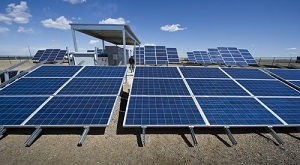Reviewing last year's solar energy news
 The solar industry had a tumultuous 2011 highlighted by dropped prices and incentives. But the industry has also showed that it’s quickly maturing.
The solar industry had a tumultuous 2011 highlighted by dropped prices and incentives. But the industry has also showed that it’s quickly maturing.
It’s hard to determine just what the biggest news in 2011 for the industry was. But these issues grabbed the most headlines.
Undoubtedly the most reported, covered, shouted, harangued and caterwauled news in solar was the bankruptcy of Solyndra. The thin-film PV company received more than $500 million in loan guarantees under the Department of Energy’s Loan Guarantee program and then went bottom up.
The program was intended to help new clean energy companies and projects get access to lower-cost financing. These included helping projects like the Ivanpah Solar Electric Generating system get underway with financing from Google and others—that project received a $1.6 billion loan guarantee.
But the program will forever be remembered for the Solyndra failure—despite the realization from the program’s onset that some projects or companies supported by the program would fail. Still, Republican candidates and conservatives have taken up the issue as a cudgel with which to batter President Obama and the administration’s support of solar and renewables.
Solyndra failed because it couldn’t compete with the lower-than-projected costs of silicon based photovoltaics. While it’s too early to say what the fall in costs over the full year of 2011 was, the installed cost of solar in the U.S. fell 17 percent from 2010, and in the first half of 2011 was expected to have fallen another 11 percent, according to the Lawrence Berkeley National Laboratory’s annual report, Tracking the Sun. The report said it was biggest year-over-year drop since it began publishing the report.
Incentives in important markets are shrinking. These include the world’s largest solar markets, like Germany and Italy. Germany’s feed-in tariff made it the biggest solar market in the world. But in January, the country announced that it was reducing the tariff by 25 percent because the program was so popular. The country will remain one of the biggest markets for solar, however. After all, in October, Germany’s KfW Bankengruppe dedicated $130 billion to solar developments in the country. Italy, the second largest PV market in the world in 2010, also reduced its solar incentive programs as the country struggled with its economy in 2011.
Despite falling prices and incentives, more players are entering the game. And by far the largest to make a big splash was General Electric.
The company announced that it is building the largest U.S. photovoltaic manufacturing plant in Colorado, where it will manufacture thin-film photovoltaics, originally developed by PrimeStar, which GE bought. The facility, when completed will have an annual production capacity of 400 megawatts of modules. Price drops in silicon PV have made it more difficult for thin-film technologies to compete, but GE is confident that its modules will be cost-competitive with silicon.
The cost wars over module prices took on a new dimension—trade war—in 2011 as well, when SolarWorld-backed Coalition for American Solar Manufacturing (CASM) petitioned the U.S. International Trade Commission to investigate Chinese PV manufacturers for unfair trade practices. But the move also has its detractors in the U.S. and—of course—in China. The Coalition for Affordable Solar Energy (CASE) was formed of solar installers and other manufacturers to oppose CASM’s complaints. While not an all-out trade war yet, the Chinese government is looking into U.S. PV trade practices as well.
Image courtesy of NREL.



